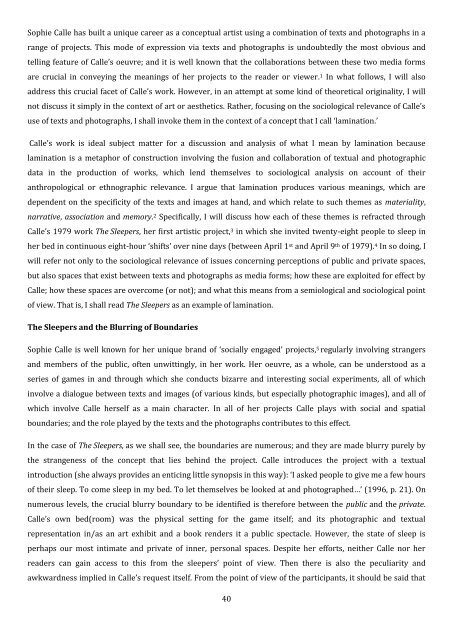download this issue as a PDF
download this issue as a PDF
download this issue as a PDF
You also want an ePaper? Increase the reach of your titles
YUMPU automatically turns print PDFs into web optimized ePapers that Google loves.
Sophie Calle h<strong>as</strong> built a unique career <strong>as</strong> a conceptual artist using a combination of texts and photographs in a<br />
range of projects. This mode of expression via texts and photographs is undoubtedly the most obvious and<br />
telling feature of Calle’s oeuvre; and it is well known that the collaborations between these two media forms<br />
are crucial in conveying the meanings of her projects to the reader or viewer. 1 In what follows, I will also<br />
address <strong>this</strong> crucial facet of Calle’s work. However, in an attempt at some kind of theoretical originality, I will<br />
not discuss it simply in the context of art or aesthetics. Rather, focusing on the sociological relevance of Calle’s<br />
use of texts and photographs, I shall invoke them in the context of a concept that I call ‘lamination.’<br />
Calle’s work is ideal subject matter for a discussion and analysis of what I mean by lamination because<br />
lamination is a metaphor of construction involving the fusion and collaboration of textual and photographic<br />
data in the production of works, which lend themselves to sociological analysis on account of their<br />
anthropological or ethnographic relevance. I argue that lamination produces various meanings, which are<br />
dependent on the specificity of the texts and images at hand, and which relate to such themes <strong>as</strong> materiality,<br />
narrative, <strong>as</strong>sociation and memory. 2 Specifically, I will discuss how each of these themes is refracted through<br />
Calle’s 1979 work The Sleepers, her first artistic project, 3 in which she invited twenty-eight people to sleep in<br />
her bed in continuous eight-hour ‘shifts’ over nine days (between April 1 st and April 9 th of 1979). 4 In so doing, I<br />
will refer not only to the sociological relevance of <strong>issue</strong>s concerning perceptions of public and private spaces,<br />
but also spaces that exist between texts and photographs <strong>as</strong> media forms; how these are exploited for effect by<br />
Calle; how these spaces are overcome (or not); and what <strong>this</strong> means from a semiological and sociological point<br />
of view. That is, I shall read The Sleepers <strong>as</strong> an example of lamination.<br />
The Sleepers and the Blurring of Boundaries<br />
Sophie Calle is well known for her unique brand of ‘socially engaged’ projects, 5 regularly involving strangers<br />
and members of the public, often unwittingly, in her work. Her oeuvre, <strong>as</strong> a whole, can be understood <strong>as</strong> a<br />
series of games in and through which she conducts bizarre and interesting social experiments, all of which<br />
involve a dialogue between texts and images (of various kinds, but especially photographic images), and all of<br />
which involve Calle herself <strong>as</strong> a main character. In all of her projects Calle plays with social and spatial<br />
boundaries; and the role played by the texts and the photographs contributes to <strong>this</strong> effect.<br />
In the c<strong>as</strong>e of The Sleepers, <strong>as</strong> we shall see, the boundaries are numerous; and they are made blurry purely by<br />
the strangeness of the concept that lies behind the project. Calle introduces the project with a textual<br />
introduction (she always provides an enticing little synopsis in <strong>this</strong> way): ‘I <strong>as</strong>ked people to give me a few hours<br />
of their sleep. To come sleep in my bed. To let themselves be looked at and photographed…’ (1996, p. 21). On<br />
numerous levels, the crucial blurry boundary to be identified is therefore between the public and the private.<br />
Calle’s own bed(room) w<strong>as</strong> the physical setting for the game itself; and its photographic and textual<br />
representation in/<strong>as</strong> an art exhibit and a book renders it a public spectacle. However, the state of sleep is<br />
perhaps our most intimate and private of inner, personal spaces. Despite her efforts, neither Calle nor her<br />
readers can gain access to <strong>this</strong> from the sleepers’ point of view. Then there is also the peculiarity and<br />
awkwardness implied in Calle’s request itself. From the point of view of the participants, it should be said that<br />
40
















